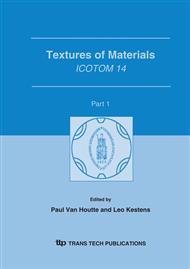[1]
Adams B.L., Henrie A., Henrie B., Lyon M., Kalidindi S.R., Garmestani H., 2001. Microstructure-sensitive design of a compliant beam. J. Mech. Phys. Solids 49, 1639-1663.
DOI: 10.1016/s0022-5096(01)00016-3
Google Scholar
[2]
Adams B.L. Lyon M., Henrie B., 2004. Microstructure by design: linear problems in elasticplastic design. Int. J. Plast. in press.
Google Scholar
[3]
Bunge H.J., 1982. Texture analysis in materials science: mathematical methods. London: Butterworth & Co.
Google Scholar
[4]
Li D.S., Garmestani H., Adams B.L., 2004a. A texture evolution model in cubic-orthotropic polycrystalline system. Int. J. Plast., accepted.
Google Scholar
[5]
Li D.S., Garmestani H. S. Ahzi, 2004b. Processing path model for the texture evolution in hexagonal materials. J. Mech. Phys. submitted.
Google Scholar
[6]
Li D.S., Garmestani H. and Schoenfeld S.E., 2003a. Evolution of crystal orientation distribution coefficients during plastic deformation. Scripta Materialia, 49, 867-872.
DOI: 10.1016/s1359-6462(03)00443-3
Google Scholar
[7]
Bunge H.J., Esling C., 1984. Texture development by plastic deformation. Scripta Met. 18, 191-195.
DOI: 10.1016/0036-9748(84)90506-4
Google Scholar
[8]
Bunge H.J., Kiewel, R., Reinert Th., Fritsche, L., 2000. Elastic properties of polycrystals - influence of texture and stereology. J. Mech. Phys. Solids 48, 29-66.
DOI: 10.1016/s0022-5096(99)00020-4
Google Scholar
[9]
Klein H., Bunge H.J., 1991. Modeling deformation texture formation by orientation flowfields. Steel Research. 62, 548-559.
DOI: 10.1002/srin.199100449
Google Scholar
[10]
Clement A., Coulomb P., 1979. Eulerian simulation of deformation textures. Scripta Met. 13, 899-901.
DOI: 10.1016/0036-9748(79)90183-2
Google Scholar
[11]
Clement A., 1982. Prediction of deformation texture using a physical principle of conservation. Mater. Sci. Eng. 55, 203-210.
Google Scholar
[12]
Kalidindi S.R., Bronkhorst C.A., Anand L., 1992a. Crystallographic texture evolution in bulk deformation processing of fcc metals. J. Mech. Phys. Solids 40, 537-569.
DOI: 10.1016/0022-5096(92)80003-9
Google Scholar
[13]
Kalidindi S.R., 2001. Modeling anisotropic strain hardening and deformation textures in low stacking fault energy fcc metals. Int. J. Plast., 17, 837-860.
DOI: 10.1016/s0749-6419(00)00071-1
Google Scholar


